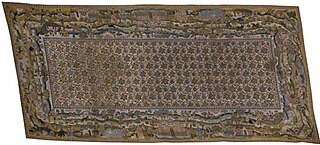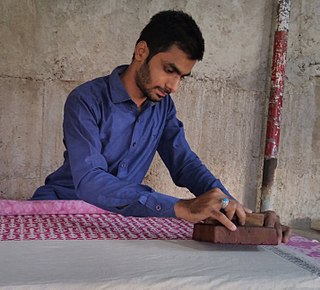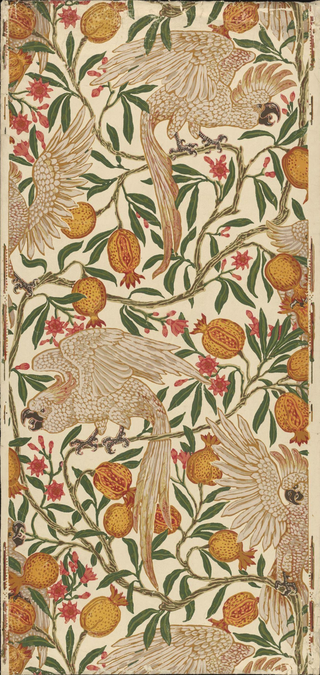
The Bradford Carpet is a canvas work embroidery made in the early 17th century that originally belonged to the Earl of Bradford at Castle Bromwich.

The Victoria and Albert Museum in London is the world's largest museum of applied arts, decorative arts and design, housing a permanent collection of over 2.27 million objects. It was founded in 1852 and named after Queen Victoria and Prince Albert.

Oscar Gustave Rejlander was a pioneering Victorian art photographer and an expert in photomontage. His collaboration with Charles Darwin on The Expression of the Emotions in Man and Animals has assured him a position in the history of behavioural science and psychiatry.
A pastry fork, pie fork or cake fork is a fork designed for eating pastries and other desserts from a plate. The fork has three or four tines. The three-tine fork has a larger, flattened and beveled tine on the side while the four-tine fork has the first and second tine connected or bridged together and beveled.

Textile printing is the process of applying color to fabric in definite patterns or designs. In properly printed fabrics the colour is bonded with the fibre, so as to resist washing and friction. Textile printing is related to dyeing but in dyeing properly the whole fabric is uniformly covered with one colour, whereas in printing one or more colours are applied to it in certain parts only, and in sharply defined patterns.

Félix Adrien Bonfils was a French photographer and writer who was active in the Middle East. He was one of the first commercial photographers to produce images of the Middle East on a large scale and amongst the first to employ a new method of colour photography, developed in 1880.

Gaetano Gandolfi was an Italian painter of the late Baroque and early Neoclassic period, active in Bologna.

Woodblock printing on textiles is the process of printing patterns on textile, usually of linen, cotton or silk, by means of carved wooden blocks.
Mary Ping is an American fashion designer based in New York City. She is best known for her conceptual label "Slow and Steady Wins the Race", although she has also designed under her own label.

Wallerant Vaillant was a painter of the Dutch Golden Age and one of the first artists to use the mezzotint technique, which he probably helped to develop.

Jo Budd is an English artist specialising in creating art from textiles. Trained as a Fine Artist her work could be described as Quilt Art, but frequently contains both collage and/or printing.
Bettina von Zwehl is a German artist who lives and works in London. She has centred her artistic practice on photography, installation and archival exploration evolving through artist-residencies in museums. Her work explores representations of the human condition and human concerns through an observational approach combined with a distinctive use of the profile view and silhouette that continues to underpin her practice.
Utagawa Kuniyasu was a Japanese artist best known for his prints in the ukiyo-e style as a member of the Utagawa school.
Mabel Phyllis Barron was an English designer, known for her textile printing workshop with Dorothy Larcher. These textiles are ‘noted for the assurance and originality of the designs, their distinctive and subtle colouring, and the quality of the materials selected’
Puttoo was the coarse woolen cloth used in and before the 19th century in the Indian subcontinent. It was stuff made of camel's hair or yak.
Klea McKenna is an American visual artist. She is known for her camera-less photography, photograms and inventive techniques using light sensitive material. Her work is included in the collections of the San Francisco Museum of Modern Art, the Los Angeles County Museum of Art, the San Francisco airport, and the Victoria & Albert Museum, London.
Peshgeer is one of the obsolete cotton piece goods produced in the Indian subcontinent. Peshgeer was a type of woven, printed material.

Jeffrey & Co was an English producer of fine wallpapers that operated from 1836 to the 1930s.
Bastienne Schmidt is a German artist who works in painting, large-scale drawing and photography.

Paul Dumas was a Parisian designer and manufacturer of wallpapers and textiles active between 1906 and 1978.













